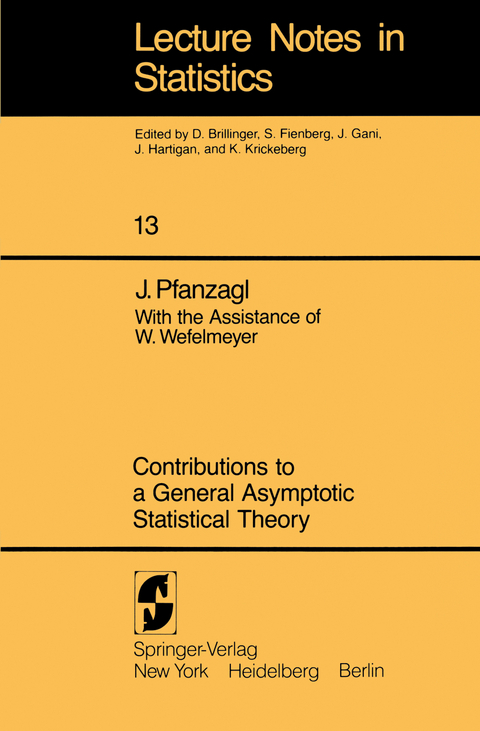
Contributions to a General Asymptotic Statistical Theory
Springer-Verlag New York Inc.
978-0-387-90776-5 (ISBN)
0. Introduction.- 0.1. Why asymptotic theory?.- 0.2. The object of a unified asymptotic theory,.- 0.3. Models,.- 0.4. Functionals,.- 0.5. What are the purposes of this book?.- 0.6. A guide to the contents,.- 0.7. Adaptiveness,.- 0.8. Robustness,.- 0.9. Notations,.- 1. The local structure of families of probability measures.- 1.1. The tangent cone T(P,?),.- 1.2. Properties of T(P,?) - properties of ?,.- 1.3. Convexity of T(P,?),.- 1.4. Symmetry of T(P,?),.- 1.5. Tangent spaces of induced measures,.- 2. Examples of tangent spaces.- 2.1. ‘Full’ tangent spaces,.- 2.2. Parametric families,.- 2.3. Families of symmetric distributions,.- 2.4. Measures on product spaces,.- 2.5. Random nuisance parameters,.- 2.6. A general model,.- 3. Tangent cones.- 3.1. Introduction,.- 3.2. Order with respect to location,.- 3.3. Order with respect to concentration,.- 3.4. Order with respect to asymmetry,.- 3.5. Monotone failure rates,.- 3.6. Positive dependence,.- 4. Differentiable functionals.- 4.1. The gradient of a functional,.- 4.2. Projections into convex sets,.- 4.3. The canonical gradient,.- 4.4. Multidimensional functionals,.- 4.5. Tangent spaces and gradients under side conditions,.- 4.6. Historical remarks,.- 5. Examples of differentiable functionals.- 5.1. Von Mises functionals,.- 5.2. Minimum contrast functionals,.- 5.3. Parameters,.- 5.4. Quantiles,.- 5.5. A location functional,.- 6. Distance functions for probability measures.- 6.1. Some distance functions,.- 6.2. Asymptotic relations between distance functions,.- 6.3. Distances in parametric families,.- 6.4. Distances for product measures,.- 7. Projections of probability measures.- 7.1. Motivation,.- 7.2. The projection,.- 7.3. Projections defined by distances,.- 7.4. Projections of measures — projections ofdensities,.- 7.5. Iterated projections,.- 7.6. Projections into a parametric family,.- 7.7. Projections into a family of product measures,.- 7.8. Projections into a family of symmetric distributions,.- 8. Asymptotic bounds for the power of tests.- 8.1. Hypotheses and co-spaces,.- 8.2. The dimension of the co-space,.- 8.3. The concept of asymptotic power functions,.- 8.4. The asymptotic envelope power function,.- 8.5. The power function of asymptotically efficient tests,.- 8.6. Restrictions of the basic family,.- 8.7. Asymptotic envelope power functions using the Hellinger distance,.- 9. Asymptotic bounds for the concentration of estimators.- 9.1. Comparison of concentrations,.- 9.2. Bounds for asymptotically median unbiased estimators,.- 9.3. Multidimensional functionals,.- 9.4. Locally uniform convergence,.- 9.5. Restrictions of the basic family,.- 9.6. Functionals of induced measures,.- 10. Existence of asymptotically efficient estimators for probability measures.- 10.1. Asymptotic efficiency,.- 10.2. Density estimators,.- 10.3. Parametric families,.- 10.4. Projections of estimators,.- 10.5. Projections into a parametric family,.- 10.6. Projections into a family of product measures,.- 11. Existence of asymptotically efficient estimators for functionals.- 11.1. Introduction,.- 11.2. Asymptotically efficient estimators for functionals from asymptotically efficient estimators for probability measures,.- 11.3. Functions of asymptotically efficient estimators are asymptotically efficient,.- 11.4. Improvement of asymptotically inefficient estimators,.- 11.5. A heuristic justification of the improvement procedure,.- 11.6. Estimators with stochastic expansion,.- 12. Existence of asymptotically efficient tests.- 12.1. Introduction,.- 12.2. An asymptotically efficient criticalregion,.- 12.3. Hypotheses on functionals,.- 13. Inference for parametric families.- 13.1. Estimating a functional,.- 13.2. Variance bounds for parametric subfamilies,.- 13.3. Asymptotically efficient estimators for parametric subfamilies,.- 14. Random nuisance parameters.- 14.1. Introduction,.- 14.2. Estimating a structural parameter in the presence of a known random nuisance parameter,.- 14.3. Estimating a structural parameter in the presence of an unknown random nuisance parameter,.- 15. Inference for symmetric probability measures.- 15.1. Asymptotic variance bounds for functionals of symmetric distributions,.- 15.2. Asymptotically efficient estimators for functionals of symmetric distributions,.- 15.3. Symmetry in two-dimensional distributions,.- 16. Inference for measures on product spaces.- 16.1. Introduction,.- 16.2. Variance bounds,.- 16.3. Asymptotically efficient estimators for product measures,.- 16.4. Estimators for von Mises functionals,.- 16.5. A special example,.- 17. Dependence — independence.- 17.1. Measures of dependence,.- 17.2. Estimating measures of dependence,.- 17.3. Tests for independence,.- 18. Two-sample problems.- 18.1. Introduction,.- 18.2. Inherent relationships between x and y,.- 18.3. The tangent spaces,.- 18.4. Testing for equality,.- 18.5. Estimation of a transformation parameter,.- 18.6. Estimation in the proportional failure rate model,.- 18.7. Dependent samples,.- 19. Appendix.- 19.1. Miscellaneous lemmas,.- 19.2. Asymptotic normality of log-likelihood ratios,.- References.- Notation index.- Author index.
| Erscheint lt. Verlag | 1.11.1982 |
|---|---|
| Reihe/Serie | Lecture Notes in Statistics ; 13 |
| Mitarbeit |
Assistent: W. Wefelmeyer |
| Zusatzinfo | 315 p. |
| Verlagsort | New York, NY |
| Sprache | englisch |
| Maße | 155 x 235 mm |
| Themenwelt | Mathematik / Informatik ► Mathematik ► Algebra |
| Mathematik / Informatik ► Mathematik ► Angewandte Mathematik | |
| Mathematik / Informatik ► Mathematik ► Statistik | |
| ISBN-10 | 0-387-90776-9 / 0387907769 |
| ISBN-13 | 978-0-387-90776-5 / 9780387907765 |
| Zustand | Neuware |
| Haben Sie eine Frage zum Produkt? |
aus dem Bereich


